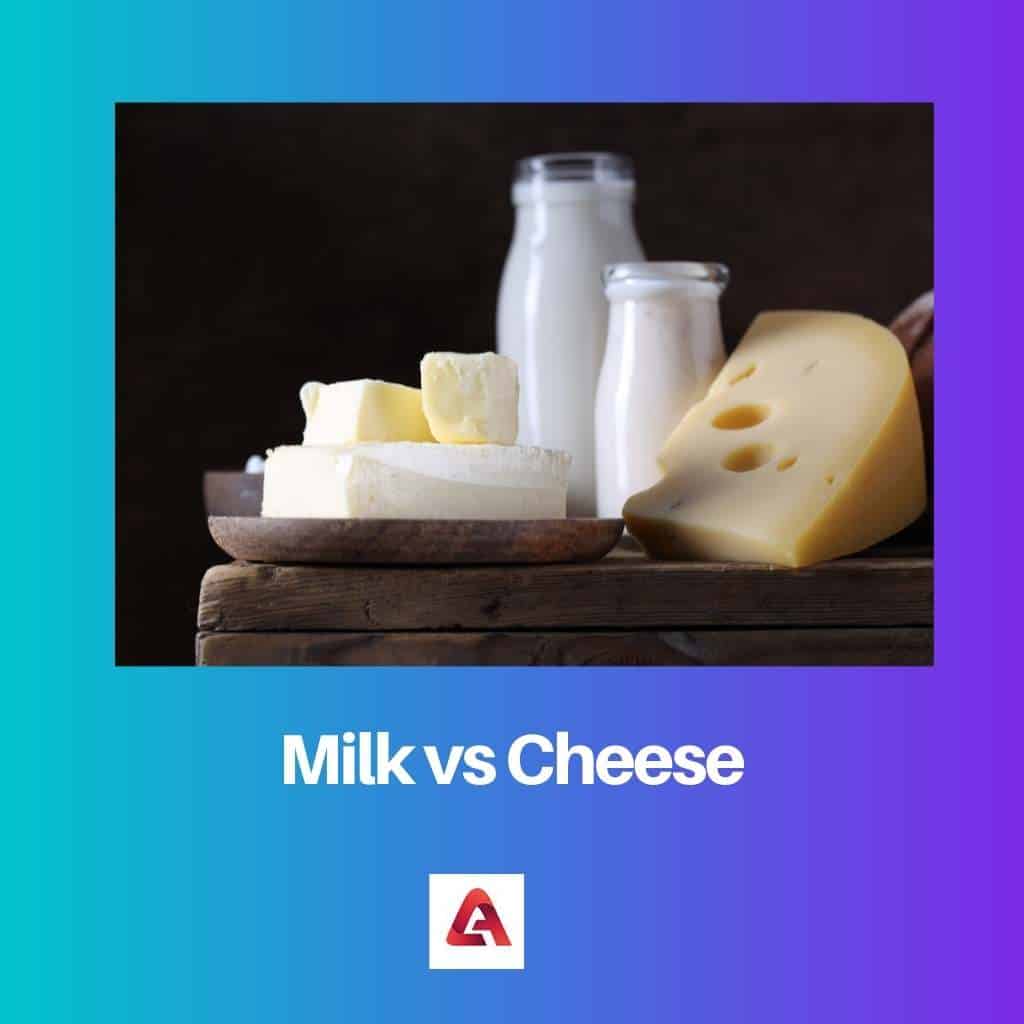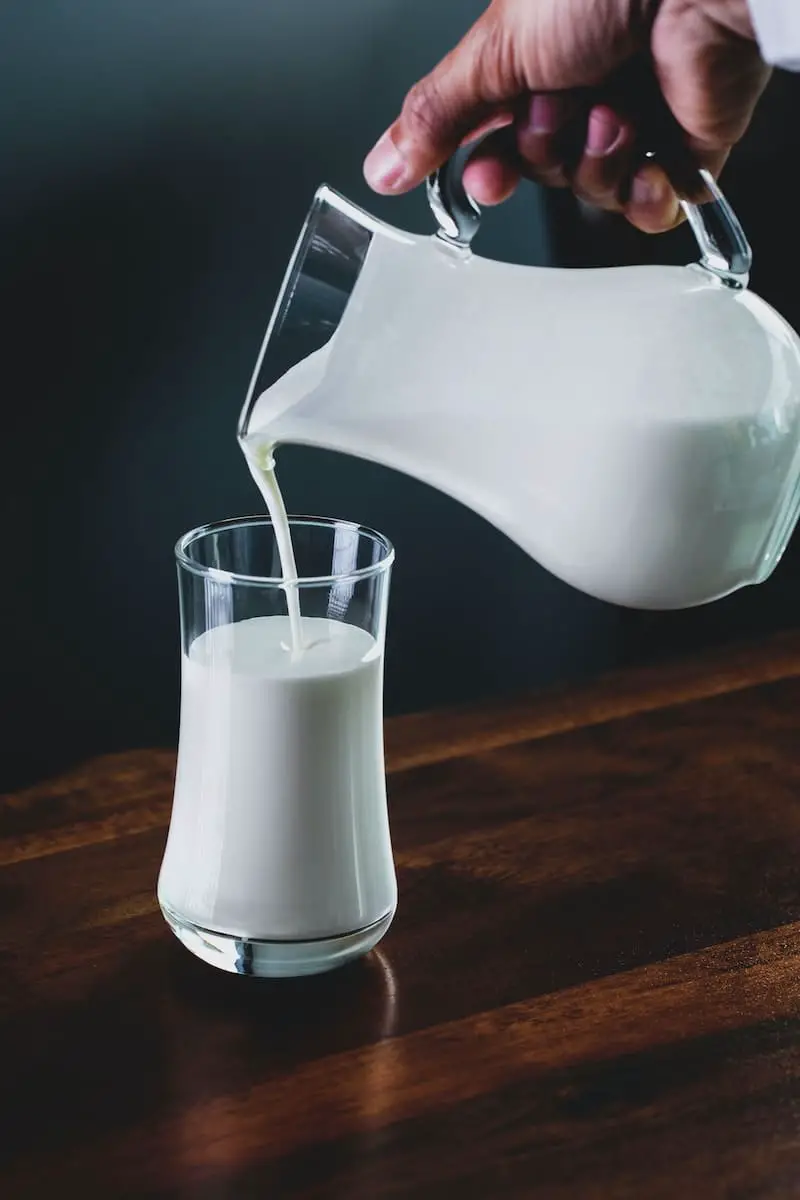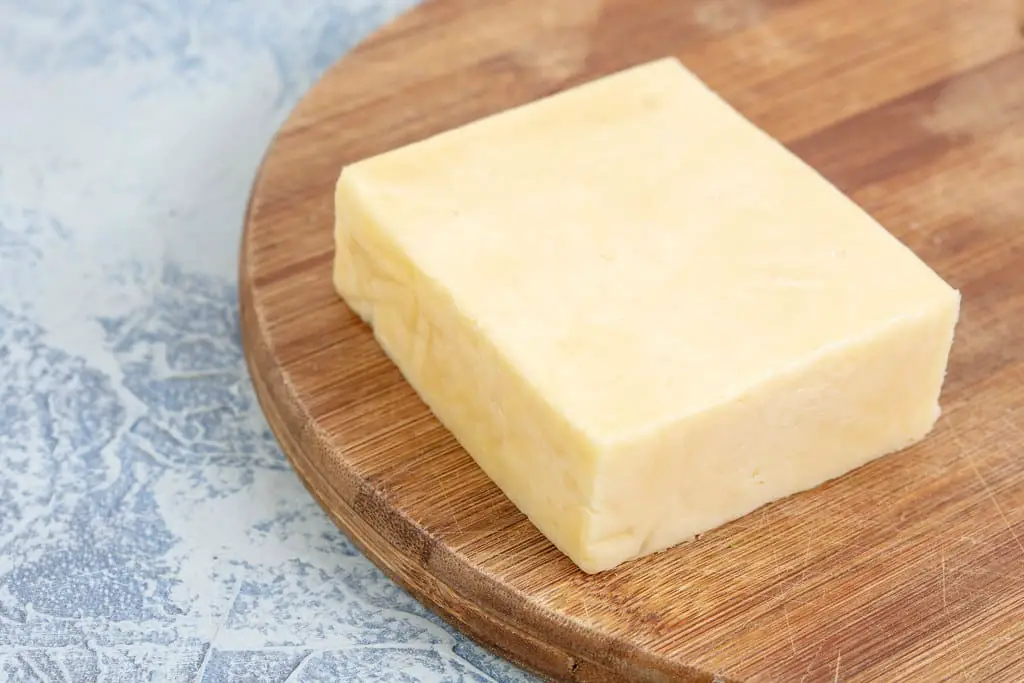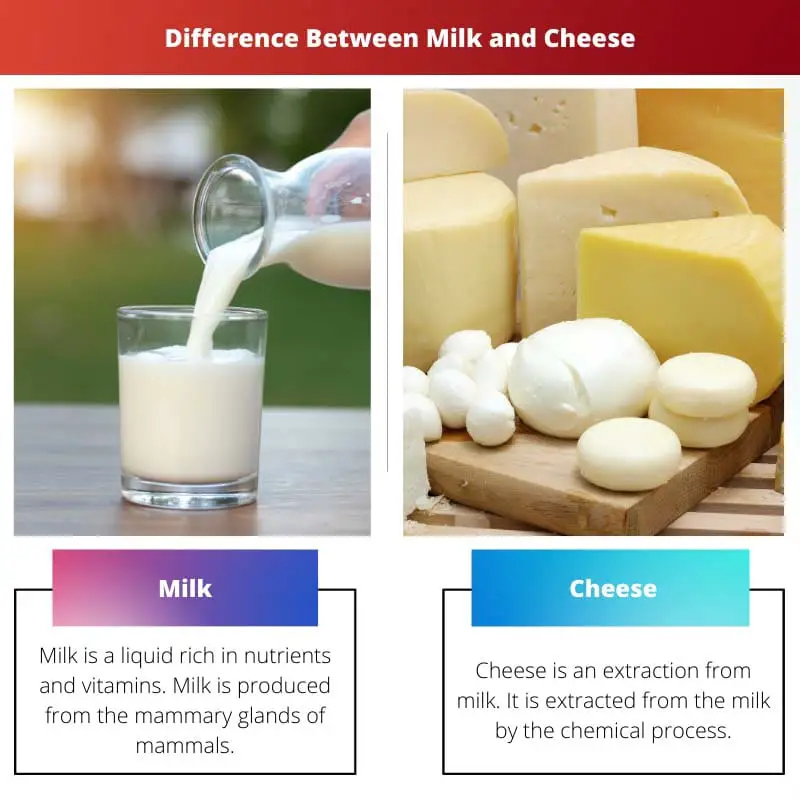Milk and cheese are to favourite items on our menu. We get confused by the covers they put on the products. Milk and cheese are two different things used as food products.
Key Takeaways
- Milk is a nutrient-rich liquid produced by mammals, whereas cheese is a dairy product made by coagulating milk proteins.
- Cheese production involves fermentation, curdling, and ageing, resulting in various flavors and textures.
- Cheese has a higher fat and protein content than milk, while milk contains more water and lactose.
Milk vs Cheese
The difference between milk and cheese is their color. Milk is white, whereas cheese is yellow. Milk is a liquid produced by mammals, whereas cheese is extracted from milk. When compared to cheese, milk has a small number of calories. Milk has 42 calories per 100 g, and cheese has 404 calories per 100 g.

Milk is a liquid rich in nutrients and vitamins. Milk is produced from the mammary glands of mammals.
The infants of mammals take milk as their primary food. Milk makes them strong through its minerals.
The milk helps to practice the digestive system for infants. Colostrum is the name for the early lactation period.
The antibodies present in the milk will help to improve the immune system. Milk acts as a major resource for many dairy products.
Protein and lactose are the major content available in milk. Human beings take milk from other mammals for their purpose.
Cheese is an extraction from milk. It is extracted from the milk by the chemical process.
Cheese is available in different flavours and textures. The coagulation of milk is called cheese.
Cheese is made from the milk of cows, goats, buffalo, and sheep. Acidified and enzyme reactions happen in the process of milk to cheese.
Bacterial enzymes are used for this process. Cheese is in solid format.
A fined cheese is prepared through different processes.
Comparison Table
| Parameters of comparison | Milk | Cheese |
|---|---|---|
| Carbs | Milk has 4.99 carbs | Cheese has 3.09 carbs |
| Lactose | Milk has a high amount of lactose | Cheese has less amount of lactose |
| Protein | Milk has less protein content | Cheese has a high protein content |
| Fats | Milk has less amount of fat | Cheese has a high amount of fat |
| Glycemic Index | The glycemic index of milk is 38 | The glycemic index of cheese is 37 |
What is Milk?
Milk is a liquid rich in nutrients and vitamins. Milk is produced from the mammary glands of mammals.
The infants of mammals take milk as their primary food. Milk makes them strong through its minerals.
The milk helps to practice the digestive system for infants. Colostrum is the name for the early lactation period.
The antibodies present in the milk will help to improve the immune system. Milk acts as a major resource for many dairy products.
Protein and lactose are the major content available in milk. Human beings take milk from other mammals for their purpose.
The largest milk producer in the world is India. It exports nearly 75% of the world’s milk needs.
Every day, the need for dairy products increases. India is the major importer of dairy products. Until 2016, the world’s largest milk product importers were China and Russia.
Followed by India, New Zealand, and Germany are the leading exporters of milk products. There is always a change in the global milk product market.
Around 6 billion people consume milk worldwide. People around the world living in dairy households are 750 billion.
From the term ‘meoluc’ of old English, the term milk originated. It means dairy products. Milk is the major source for all mammals.
Breastfeeding is a vital thing for infants of human beings. The World Health Organization advised that six months of breastfeeding is needed for the infants to be strong.
The electrotype imbalances can be controlled by goat’s milk in the case of a mother’s death or unavailable breast milk. It also cures metabolic acidosis and allergic reactions.

What is Cheese?
Cheese is an extraction from milk. It is extracted from the milk by the chemical process.
Cheese is available in different flavours and textures.
The coagulation of milk is called cheese. Cheese is made from the milk of cows, goats, buffalo, and sheep.
Acidified and enzyme reactions happen in the process of milk to cheese. Bacterial enzymes are used for this process.
Cheese is in solid format. A fined cheese is prepared through different processes.
Cheeses have aromatic flavours, and it is moulded. The cooking temperature is enough to melt the cheese.
Nearly a thousand types of cheese are available in the world. Millions of dishes are produced using cheese. Every country has its own cheese flavours and textures.
It is available in yellow and red color. Annatto is a flavour added to the color of the cheese.
Black pepper, garlic, and cranberries are some other ingredients added with cheese for flavour.
By adding acid and vinegar to the milk, cheese is created. The bacteria react with milk sugars.
Fermentation is when fungus mucous reacts, and cheese is produced. Their different range of cheese is available at different prices.
Cheese is rich in protein, vitamin D, and calcium. Cheese-producing industries are concentrating on their packaging.
The package decides the quality of the products even after many days of transportation.

| # | Preview | Product | |
|---|---|---|---|
| 1 |

| Horizon Organic American Cheese Slices, 8 oz. Pack, 12 Slices | Check Price on Amazon |
| 2 |

| 365 by Whole Foods Market, Cheese String Mozzarella 12 Count, 12 Ounce | Check Price on Amazon |
Main Differences Between Milk and Cheese
- The glycemic index of milk is 38, and the glycemic index of cheese is 37.
- Milk is rich in vitamin A, whereas cheese is rich in vitamin D.
- Milk is in liquid format, whereas cheese is in solid format.
- Milk has less protein content, and Cheese has a high protein content.
- Milk has a high amount of lactose, and Cheese has less amount of lactose.

- https://www.sciencedirect.com/science/article/pii/S002203028979319X
- https://onlinelibrary.wiley.com/doi/abs/10.1002/jsfa.2740080712



I found the section comparing the carbohydrates, lactose, protein, fats, and glycemic index of Milk vs Cheese to be very eye-opening. There’s a lot we don’t realize about these products!
I would have liked to see some more quantitative data to support the claims made in the article. Interesting read, though.
It’s fascinating to learn about the history and production process of both milk and cheese. Very enriching!
The comparison table is particularly useful, and the information is easily understandable.
Very informative reading, it’s always good to know more about the products we consume on a daily basis. Thanks for sharing!
It is very informative to know that milk has a high amount of lactose, unlike cheese. It could be beneficial for those who are lactose intolerant.
The article does a good job of comparing the main differences between milk and cheese. The references provided are also helpful.
This is great information for people who want to know the differences between milk and cheese. It also helps shows the way the two foods are made and their nutritional information quite clearly.
The content of the post is very comprehensive. It also contains a lot of detailed information that could be interesting for a variety of readers.
I found the section comparing Milk and Cheese very superficial. More in-depth analysis is needed for such an important differentiation.